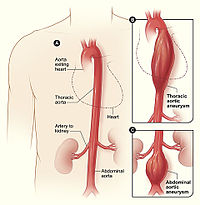
Photo from wikipedia
Background: While the most intracranial aneurysms are approachable by femoral or brachial artery puncture during endovascular surgery, in some cases, the lesion is difficult to reach due to complications such… Click to show full abstract
Background: While the most intracranial aneurysms are approachable by femoral or brachial artery puncture during endovascular surgery, in some cases, the lesion is difficult to reach due to complications such as the presence of winding pathways. Direct carotid puncture (DCP) is an alternative access approach, despite the potential risk of fatal neck hematoma. Herein, we describe the DCP technique in a series of five patients with intracranial aneurysms, together with its technical considerations. Methods: Patients with intracranial aneurysms who underwent endovascular surgery using DCP were reviewed retrospectively. We selected the 3F to 6F systems for DCP depending on the necessity of adjunctive techniques. To prevent DCP-associated complications, we (1) conducted a micropuncture before introducing the short sheaths, (2) selected the smallest possible size for the system, (3) reversed heparin postoperatively, and (4) performed perioperative intubation/sedation management. Results: Five out of 535 patients underwent DCP in our hospital between 2015 and 2019; successful vascular access was achieved in all cases. Although a minor neck hematoma occurred in one case, the patient did not require additional treatment. According to a literature review, severe neck hematoma requiring rescue therapy occurs in 5 out of 95 cases (5.3%). Conclusion: Although the potential risk of neck hematoma is not negligible, the DCP technique appears to be a safe and effective approach in treating intracranial aneurysms with challenging access routes in cases where perioperative counter measurements are appropriately performed.
Journal Title: Surgical Neurology International
Year Published: 2022
Link to full text (if available)
Share on Social Media: Sign Up to like & get
recommendations!